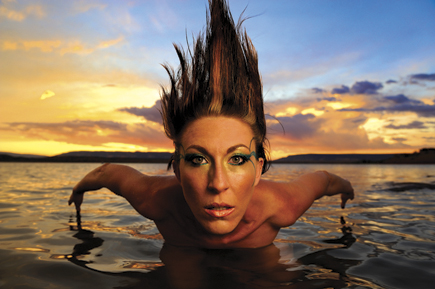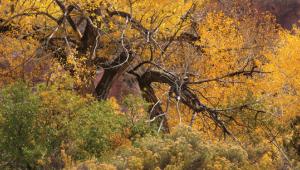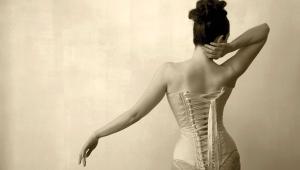Interview With Joe McNally; The Life And Times Of A Master Craftsman Page 2
I went to school to be a writer. My books and the blog have enabled me to re-embrace that art form. I really have a good time doing that because I enjoy writing. If truth be told, I enjoy it almost as much as I do photography. You sit down and plan to write the story of what just happened to you in the field, and it’s inevitably kind of ridiculous, humorous, and mildly compelling, because it’s the stuff that happens to a photographer in the field.
We were teaching yesterday and we had these four models sitting on this World War II Jeep in front of a Destroyer in the Boston Shipyard. We didn’t know it, but the place was closing. So this guy just walked over while I’m shooting, I had 75 people around and these models on a Jeep, and the guy just came to the Jeep, turned it on and said I’ve got to take the Jeep. There went the prop. The class just convulsed; I turned around and said this is what happens on location. Everybody can send you down the tubes on location, from your subject to the freight elevator guy.
 |
SB: So many of the images you create seem magical, even when you are teaching a workshop. Can you tell us about your thought process, give our readers a sense of how you connect, overcome problems, and deliver such excellent work?
JM: Let’s first get something on the table; it’s not all magical work. Sometimes you have your ups and downs. It’s like playing a sport; you have your good days and bad days. But I do think the core of what keeps me going forward is basic love and enthusiasm for being a photographer.
Your digital contact sheet shows your thought process, from the first frame where you’re just doing location assessment and following that through, it’s your thought process right there. When I came up photographically, really good photo editors couldn’t care less about your portfolio, you know, your greatest hits. They were like yeah, sure kid, yeah that’s nice, but let me see your contact sheets.
Your contact sheets are the road map for what you’re thinking when you have a camera in your hand. If you go through a digital take when you are building a solution, lighting, or whatever, you go back through that and you’ll see the photograph build. You see frames where you misfired, frames where things were off, and then finally, usually through this process, you establish what I refer to as clarity of thought.
I teach a lot of lighting; people are messing with the lighting, but I say look, before you start messing with the lighting, you’ve got to mess with the picture. Where the camera goes is much more important than where the light goes. Once you figure out where the camera goes, then putting the light in an effective place is much easier.
 |
SB: When Nikon introduced the Creative Lighting System (CLS) in 2003, they asked you to create the DVD “Speed of Light,” which really showed what the system could do. Did it take you long to grasp and master CLS?
JM: Yes and no. Not to come down the middle there, but no in the sense that once you crank through the buttons and dials the first few times it becomes pretty intuitive. Physically working the flashes is not too much of an issue. Wrangling good light from small spectral light sources like these becomes the larger issue for me—how to craft that in the same way as if you were shooting bigger studio lights. The CLS, as Nikon brought it out, is a truly wonderful flash system because it works.
Does it have glitches, ups and downs, misfires, and stuff like that? Of course, every camera and every system does, and I think that that’s where some folks get a little frustrated. I always remind people that it’s a TTL system, Through The Lens, so when you point the lens at something, all that exposure information is streaming into the camera. You shift your angle, change your lens, you’re going to get a different stream of photo information or exposure information, which is going to send a different message to your flash.
Therefore, the flash will react in a way that it thinks is appropriate but it might be way off and you say hey, wait a minute, it was fine a minute ago. Then you start to identify situations where TTL is going to not work so well, and other situations you walk in and see immediately that this is tailor-made for TTL.
The nice thing about the lights is that by working with the information that’s occurring at the moment of exposure, you’ve got a tremendous amount of intuitive technology to use, which is pretty great. I always regard it as a gift. Young photographers sometimes get frustrated with it and I’m like hey, wait a minute dude, you know, not too long ago we were out there with a couple of rocks trying to make sparks. This is very sophisticated stuff that we’re doing now, so just roll with it.
 |
SB: What about your workflow? Can you tell us a little bit about the technical side and how you review and post-process your final images?
JM: My camera system is Nikon and I’m shooting D3s. I shoot Lexar cards. All the imagery is organized in Aperture libraries and we use Aperture as a management program: sorting, pulling, slide shows, and this and that. I do raw finishing in Nikon Capture NX 2 and then the final shaping and presentation of the imagery in Photoshop CS4. My assistant and I have MacBook Pros and we have three Macs in the studio with the Cinema Displays and a Wacom Cintiq. Let me also issue this disclaimer, I don’t do much retouching. I’m not good at it; I’ve tried off and on to learn about it, but I’ve been staying kind of busy, so it’s a little hard and a little elusive for me. If there is any post-processing and finishing to be done, my assistant does it and we consult with each other.
 |
SB: Do you have any advice for photographers who are struggling to maintain their love of photography and their professional standing, things that have helped you deal with these difficult economic times?
JM: Tenacity is definitely part of the equation, always has been, probably even more so now. There’s a lot of competition out there and there’s a lot of retrenching on the part of clients. Money that they might have spent in a more freewheeling way, they’re watching much more carefully and they’re deciding to go with last year’s pictures or stock images as opposed to generating work. I’m facing the same thing, absolutely. I have a new story coming out for Geographic in June. I shot two stories for them last year and I haven’t heard from them so far this year. We’ll see where that goes.
When I was a staff photographer at Life magazine, it was an interesting and blessed position. I really had kind of a benevolent patron who would listen to my ideas and fund them if the editors found them worthwhile. Now, so much of that is back on the photographer’s shoulders, finding funding, going forward, and generating ideas. It’s pretty madcap in lots of ways, the whole idea of trying to make a living as a photographer now is a high-wire act. Tenacity is a huge part of the equation as well as the ability to maintain good humor and a positive outlook despite the fact that you’re hearing the word “no” a great deal.
You have to be able to keep moving forward and you have to keep apprised of new technology. To have a market presence as a photographer, a blog, or certainly a website, is required. It’s a way of communicating and letting people know that you’re out there.
Also, try your best to remain aggressive, even in lean times. I think it’s important for photographers because if you look through your portfolio, your best pictures have almost always occurred when you took a risk. Whether that is creative, emotional, financial, or whatever it might be, and nowadays the word is to be risk-adverse. You know, shutter your doors, close down, do nothing, and weather the storm. But I would argue that no matter what, to the best of your ability, you have to keep creating work and taking chances. You have to keep pushing your own envelope or you’ll wither right along with the economy.
Larry Berman and Chris Maher are photographers, writers, and web designers, specializing in image-intensive photography sites. For more information visit their websites at: www.BermanGraphics.com and www.InfraredDreams.com.
- Log in or register to post comments

















































